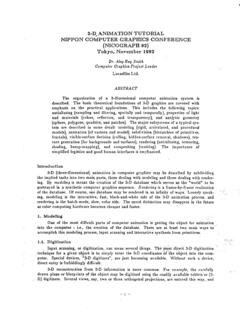Transcription of ISSN 2249-6343 Volume 2, Issue 2 Wireless Design for Power ...
1 ISSN 2249-6343 International Journal of Computer Technology and Electronics Engineering (IJCTEE) Volume 2, Issue 2 119 Abstract Aiming at the disadvantage of current anti-theft technology, a novel smart grid based Wireless Power theft monitoring system is proposed in this paper. The system consists of multiple smart Wireless transformer sensor node, smart controlling station, smart transmission line sensor node, and smart Wireless consumer sensor node. The proposed software module also incorporates different data aggregation algorithms needed for the different pathways of the electricity distribution system. This Design incorporates effective solutions for problems faced by India s electricity distribution system such as Power theft, and transmission line fault. The proposed architecture is designed for single phase electricity distribution system, and this Design can be implemented for three phase system of electricity distribution with minor modifications.
2 Index Terms smart grid, Wireless sensor networks, single phase system, three phase system. I. INTRODUCTION Many developing countries confront widespread theft of electricity from government owned Power utilities. In India electricity theft leads to annual losses estimated at US$ billion, about percent of GDP. Who are the losers? Honest consumers, poor people, and those without connections, who bear the burden of high tariffs, system inefficiencies, and inadequate and unreliable Power supply. Line faults may be caused due to over current or earth fault. If there happens to be a connection between two phase lines then over current fault occurs. Earth fault occurs due to the earthing of phase line through cross arm or any other way. Now in India, there is not any technique to detect the specific location of the fault immediately.
3 Power theft is another major problem faced by Indian electrical system. These two problems can be solved effectively through this architecture. By the proposed architecture the above mentioned problems can be solved. Parul Ranjan, E&TC Department, Pune University/ (e-mail: Loni, India, Mobile No.+918796312803. Namita Mehra, E&TC Department, Pune University/ Loni, India, Mobile No.+919960287467,( e-mail: Prof. More, E&TC Department, Pune University/ Loni, India, Mobile No.+919423148998,( e-mail: Shripad Bokand, E&TC Department, Pune University/ Loni, India, Mobile No.+919579265969,( e-mail: II. THE PROPOSED ARCHITECTURE The whole system architecture is based on integrating Wireless network with existing electrical grid. The architecture consists of four modules namely, Controlling Station (CS), Wireless Transformer Sensor Node (WTSN), Transmission Line Sensor Node (TLSN), Wireless Consumer Sensor Node (WCSN).))))
4 The proposed architecture is shown in Figure1. Figure 1. Proposed Architecture WCSN is a consumer Power metering device that measures the Power consumed by the consumer and send the data periodically to the WTSN. Each feeder of the transformer has a WTSN which monitors Power through each line and collects data from WCSN aggregate it and send to the CS. TLSN is another module associated with distribution line, mounted in each distribution line posts [1]. III. BLOCK DIAGRAM A. Block diagram description 1) Zigbee: We are using XBee-PRO OEM RF Module. It is engineered to meet IEEE standards and support the unique needs of low-cost, low- Power Wireless sensor networks. The modules require minimal Power and provide reliable delivery of data between devices. The modules operate within the ISM GHz frequency band and are pin-for-pin compatible with each other.
5 The XBee-PRO OEM RF Modules interface to a host device through a logic-level asynchronous serial port. Wireless Design for Power Theft Monitoring 1 Parul Ranjan, 2 Namita Mehra, 3 Prof. More, 4 Shripad Bokand Line 1 Line 2 Line 1 consumer Line 2 consumer Line 3 consumer WCSN WCSN WCSN TLSN T R A N S F O R M E R WTSN WTSN WTSN Line 3 ISSN 2249-6343 International Journal of Computer Technology and Electronics Engineering (IJCTEE) Volume 2, Issue 2 120 Figure 2: Block Diagram Figure 2. Block diagram of Power theft monitoring system Through its serial port, the module can communicate with any logic and voltage compatible UART; or through a level translator to any serial device. 2) Current Transformer Circuitry: We are using Allegro ACS709 current sensor IC. The ACS709 consists of a precision linear Hall sensor integrated circuit with a copper conduction path located near the surface of the silicon die.
6 Applied current flows through the copper conduction path, and the analog output voltage from the Hall sensor IC linearly tracks the magnetic field generated by the applied current. The accuracy of the ACS709 is maximized with this patented packaging configuration because the Hall element is situated in extremely close proximity to the current to be measured. 3) Microcontroller: The LPC2148 microcontroller is based on a16-bit/32-bit ARM7 TDMI-S CPU with real-time emulation and embedded trace support that combine the microcontroller with embedded high-speed flash memory ranging from 32 kB to 512 kB. A 128-bit wide memory interface and unique accelerator architecture enable 32-bit code execution at the maximum clock rate. For critical code size applications, the alternative 16-bit Thumb mode reduces code by more than 30 % with minimal performance penalty.
7 Due to their tiny size and low Power consumption, LPC2148 is ideal for applications where miniaturization is a key requirement, such as access control and point-of-sale. Serial communications interfaces ranging from a USB Full-speed device, multiple UARTs, SPI, SSP to I2C-bus and on-chip SRAM of 8 kB up to 40 kB, make these devices very well suited for communication gateways and protocol converters, soft modems, voice recognition and low end imaging, providing both large buffer size and high processing Power . 4) LCD: LCD stands for Liquid Crystal Display. As the output of our circuit should be displayed in some form or the other, so we have selected LCD display as it can display 16 characters at a time. It is also easy to interface with the microcontroller without any decoder. So it is better than the seven segment display.
8 IV. ALGORITHM System powered on System initializing Slave Zigbee acknowledges to master addressing. Master microcontroller (attached to master zigbee) compares the Power consumption from all slave zigbee to that of itself. Node microcontroller plus zigbee compares Power consumption downstream its position. If the comparison in last step (5th) is equal, that sector is OK. If the comparison in last step (5th) is unequal, response from all consumers zigbee is less than Power being provided; sensor/zigbee at that node will transmit a theft signal to its master along with difference. Master node will compare the Power consumption from all its slave nodes & last consumer. If the comparison in the 8th step the shortage is equal to the shortages from all slave nodes (under the authority of that master node), then consumers directly consuming from that master node is not stealing electricity.
9 That sector is ok. If the comparison in the 8th step the shortage of master node is more than that of all slaves node under its authority, then the consumer under its direct controller is also involves in theft. Node Wireless Sensor Zigbee Wireless Module Buzzer Current Transformer Circuitry Circuit Breaker Microcontroller Power Supply L C D Node Wireless Sensor Zigbee Wireless Module Buzzer Current Transformer Circuitry Circuit Breaker Microcontroller Power Supply Node Wireless Sensor Zigbee Wireless Module Buzzer Current Transformer Circuitry Circuit Breaker Microcontroller Power Supply L C D LCD Host Controller ISSN 2249-6343 International Journal of Computer Technology and Electronics Engineering (IJCTEE) Volume 2, Issue 2 121 All areas can be scanned & red alert of theft can be transmitted to the master zigbee along with the information of sectors where Power loss is occurring whether due to theft or other means.
10 V. WORKING OF Wireless SENSOR NETWORK The sensor network monitors the electrical grid for a specified period of time, which may be daily, monthly or yearly. Thus the WTSN stores the maximum demand for each consumer including the losses. This value is updated only when a new consumer becomes the part of the network [7]. The measured data from each WCSN is send to the neighboring TLSN. The aggregated data is then sent to the next nearby WLSN. Thus the data transfers from WCSN to the corresponding WTSN through TLSN. The collected data is compared with the measured data by the energy meter plus DLl in each TLSN. Normally these two data are almost same. If there is any difference (dmc) in the collected data and the measured data, there may be a line fault or a Power theft in that segment. Large value of dmc indicates a line fault and small value of dmc indicate a Power theft.




